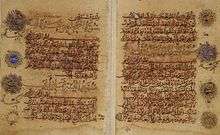Ibn al-Bawwab
Ibn al-Bawwāb was a Persian calligrapher and illuminator who lived during the time of the Buyid dynasty. He most likely died around 1022 AD in Baghdad.[1]
Ibn al-Bawwab | |
|---|---|
 Ibn al-Bawwab script seen here is the earliest existing example of a Qur'an written in a cursive script, Chester Beatty Library | |
| Died | 1022 |
| Known for | Islamic calligraphy |
| Movement | Naskh Thuluth muhaqqaq |
| Wikimedia Commons has media related to Ibn al-Bawwab. |
Life
Ibn al-Bawwāb was from a poor family. His name literally translates as the “son of the doorkeeper.” He was trained in law and theology, was very devout and is said to have been able to recite the Qurʾān from memory.[2]
He studied calligraphy with the daughter of Ibn Muqla. He was fluent in all six scripts and refined them. He achieved fame in his own lifetime and was readily recognised by his long beard. His students carried his improved style through to succeeding generations of calligraphers.[3]
Altogether, Ibn al-Bawwāb reputedly produced 64 copies of the Qurʾān. One of the most beautiful in the rayḥānī script is in the Laleli Mosque in Istanbul, and another is in the Chester Beatty Library in Dublin, Ireland.[4] a gift of the Ottoman Sultan Selim I (1470–1512). Ibn al-Bawwāb was recognized as a master in his own time; his school of calligraphy lasted until Baghdad fell to the Mongols more than two centuries after his death.[1]
Works
One of his greatest achievements was the perfection of the al-Khatt al-Mansub (literally, the well-proportioned script) style of Islamic calligraphy. He also contributed to the development of many of the early cursive scripts including rayḥānī, naskh, tawqīʿ and muhaqqaq.[1] Only one of Q'ran by al-Bawwab is known to have survived. It is the earliest extant manuscript written in cursive script on paper. [5]
See also
References
- "Ibn al-Bawwāb brief bio". Retrieved 2012-09-14.
- "Ibn al-Bawwab" [Biography], Encyclopedia Britannica, Online:
- Robinson, G., The Cambridge Illustrated History of the Islamic World, Cambridge University Press, 1996, p. 268
- http://www.cbl.ie/Collections/The-Islamic-Collection/The-Qur-an-Collection.aspx
- Robinson, F (ed.), The Cambridge Illustrated History of the Islamic World, Cambridge University Press, 1996, p. 286